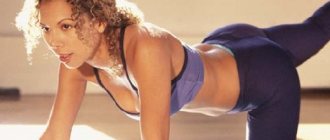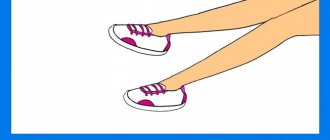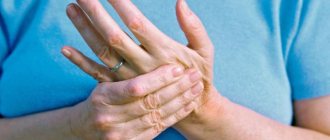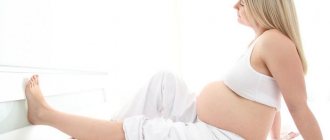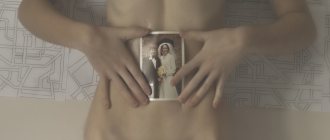Cold and hot shower
Due to the sharp change in temperature, the blood vessels in the legs quickly narrow and immediately expand. This “training” of the circulatory system helps relieve muscle tension and remove lactic acid from the tissues. Therefore, such a procedure helps relieve fatigue after intense physical activity.
If you don't have the strength to take a full shower, replace it with foot baths with hot and cold water. Just alternately lower your legs into one container, then into another, and after 5-10 minutes the fatigue will pass. If you plan to rest after finishing the procedure, finish it with a bath of warm water. To tone up, finish the procedure with cool water.
Herbal baths
Using a decoction of medicinal herbs, you can get rid of not only fatigue or swelling, but also small wounds on the skin if, for example, you rubbed your feet with new shoes. To carry out a useful procedure, use these medicinal herbs:
- nettle and chamomile normalize the functioning of the sebaceous glands, enhance tissue regeneration, and also reduce swelling and pain. An infusion of these herbs is used for joint diseases, as well as if it is necessary to restore skin worn off by new shoes;
- a decoction of St. John's wort relieves physical fatigue and swelling, and also increases blood flow;
- Linden baths reduce inflammation and activate sweating. Therefore, linden blossom is recommended for use in cases of severe swelling and damage to the skin.
If desired, you can mix decoctions made from different herbs in one bath.
Causes of fatigue and heaviness in the legs
There are several reasons that cause fatigue and heaviness in the legs. The wrong choice of shoes leads to such consequences. It can be tight or made of artificial materials. If you spend a lot of time in such shoes, it will affect the health of your feet.
Very often the described problem “lurks” among athletes or fitness enthusiasts. Heavy training is stressful for the whole body and very often it is the legs that suffer from overestimating their strength.
For women, the most common problem with foot fatigue is high-heeled shoes. Of course, such shoes can emphasize the style and taste of their owner. But, there is no need to use stiletto heels as shoes for everyday wear.
Fatigue in the legs can very often be a syndrome of serious diseases associated with insufficient blood flow to the legs. This may be due to the formation of atherosclerotic plaques. This problem often occurs in people with high cholesterol levels, smokers and people with diabetes.
Swelling of the legs
Fatigue and tiredness of the legs can be affected by flat feet, varicose veins and other problems. They often manifest themselves as pain and cramps in the calf muscles.
IMPORTANT: Diseases of the blood vessels, joints and muscles of the legs can lead to heaviness in the legs and rapid fatigue. Often this problem is caused by a disease of the spine. If such heaviness in the legs is accompanied by pain in the heart area, then this may be a symptom of cardiovascular disease.
Sea salt baths
Sea salt relieves physical stress and fatigue, and also reduces inflammation and swelling. Sea salt baths can be used not only to relieve fatigue, but also to combat joint diseases. In addition, this product has a softening effect on the skin and normalizes the functioning of the sebaceous glands. Use sea salt as follows:
- Pour 4-6 liters of warm water into a small bowl and add 1-2 tbsp. l. sea salt;
- immerse your feet in the saline solution for 10-15 minutes;
- After finishing the procedure, dry your feet and go to rest.
To enhance the effect, you can do a light foot massage with moisturizer.
Restless legs syndrome treatment with folk remedies
What is restless legs syndrome (RLS), its symptoms, causes. What medications are used to treat restless legs syndrome? Treating RLS at home. What should you do to prevent RLSExamples of recoveryREVIEWS
What is restless legs syndrome (RLS)? Symptoms
From a conversation with Doctor of Medical Sciences A. S. Kadykov. For every fifth person suffering from insomnia, the cause of sleep disturbance is discomfort in the lower extremities. It is not pain, nor itching, nor numbness.
When examining such a person, no pathologies are found; the joints, blood vessels are all fine. And mentally the person is healthy. Therefore, RLS is diagnosed quite rarely, although it occurs frequently.
Apart from unpleasant sensations during sleep, patients have nothing to complain about, which is why they do not go to doctors.
The disease begins to appear after 40-50 years, and the number of patients increases with age. Women get sick more often than men by 50%.
How to calm your feet?
From a conversation with Doctor of Medical Sciences R. V. Buzunov. Restless legs syndrome (RLS) is a neurological disease, the symptoms of which are discomfort in the lower extremities.
There is no pain, but there is a burning sensation, tingling, goosebumps, pressure, twitching - all this forces the patient to constantly move his legs or walk, because with movement these symptoms weaken. Symptoms intensify in the evening and subside in the morning. At the same time, a person cannot sleep normally; the disease greatly exhausts the nervous system.
In approximately 30% of patients, the disease is defined as a hereditary disease. This is the primary RLS. Secondary syndrome develops when there is a lack of iron in the body, against the background of kidney failure, spinal injuries, diabetes, etc. - in this case, the underlying disease must be treated.
Primary RLS is associated with biochemical processes in the brain, in particular with a lack of dopamine, a substance that regulates motor activity.
Doctors often find it difficult to determine the diagnosis, mistakenly linking the disease with pathology of the veins and joints, and prescribing the wrong treatment. Therefore, the patient must describe in detail to the doctor the symptoms and nature of the discomfort.
Cause
The causes of restless legs syndrome are not well understood, and sometimes the condition is inherited. Diabetes mellitus, renal failure, hypothyroidism, anemia, and Parkinson's disease contribute to its development, but these diseases are not the root cause.
RLS can be caused by certain medications, such as antipsychotics and lithium.
Treatment of RLS with medications
What medications can treat restless legs syndrome? How to soothe your feet? Medicines that treat Parkinson's disease and epileptic seizures (mirapex, madopar, nacom, clonazepam) are recommended. If these drugs are given before bedtime in a small dose, the patient sleeps peacefully until the morning.
These medications do not cure RLS, but only relieve symptoms, so they must be taken continuously. You shouldn’t be afraid of this, because for Parkinson’s disease, medications are also taken for life, and there is no harm from them. And patients with RLS take the medicine in minimal doses and only once a day. It is much more dangerous to take sleeping pills.
In addition, if you take medications that relieve the symptoms of RLS, you won’t need sleeping pills. It is not recommended to take 2-3 medications, because a person will not be able to understand what made him feel better and what made him worse.
And if the patient still takes sleeping pills, then herbal remedies that calm the nervous system are more useful: infusions of valerian, motherwort, St. John's wort or ready-made herbal preparations, for example, “Novo-Passit”. To sleep soundly, you need to get a massage before going to bed.
It is better to use massagers, manual or mechanical, needle or roller. Everyone must choose the device individually. You can simply massage your feet and legs with a rich cream.
Feet with RLS prefer warmth; in cold weather the disease intensifies.
Treatment with mirapex. Until recently, RLS was treated with tranquilizers, and in severe cases with narcotic drugs, they alleviated the symptoms, but there were more side effects than benefits.
Now there are stimulants of dopamine receptors in the brain, one of them is the drug mirapex, which in minimal doses will almost 100% help cure this disease. For Parkinson's disease, this drug is taken 3 tablets per day.
Mirapex for restless legs syndrome, take 1/4-1/2 tablets once a day before bedtime. The results of treatment become noticeable almost on the very first night - patients begin to sleep peacefully.
What to do if a person wakes up at night from RLS? You can walk around or hold your feet under running warm water, but then you can completely drive away sleep. It's better to sit on the bed and massage your feet.
How to treat restless legs syndrome at home?
For mild forms of RLS, distraction therapy is possible - intense rubbing, foot baths with cold or hot water, exercises before bed. Do not take sleeping pills, it is better to drink valerian, motherwort, St. John's wort in the form of alcohol tincture or tea before going to bed. (source: ZOZH 2009, No. 22, p. 23).
Folk remedies for treating RLS
Homemade horseradish treatment. The woman's legs had been bothering her for a long time. I once read in the newspaper what drug helps with this scourge. I went to buy it at the pharmacy, but it turned out to be very expensive and had many contraindications. I decided to endure it further. Once a woman injured her knee joint, it began to hurt very much. Friends advised me to tie horseradish leaves to the joint.
But wearing a compress all the time was inconvenient. Then the woman decided to make a tincture based on horseradish; she steeped the crushed roots and leaves of horseradish in moonshine for 4 days. And she began to rub her legs with this tincture, from her feet to her knees. Soon she noticed that her legs no longer bothered her - she went to bed and immediately fell asleep, not paying attention to her legs.
I realized that I had invented my own folk remedy for restless leg syndrome. I recommended this product to my friends, and it helped them too. (source: newspaper “Vestnik ZOZH” 2011, No. 19 p. 33). Calming homemade tinctures. The woman began to notice that her legs began to “dance” in the evenings.
I found out that the cause of this (BN syndrome) is diabetes mellitus, varicose veins or increased nervous excitability. She didn’t have the first two illnesses, so she decided to strengthen her nerves. At the pharmacy I bought 100 ml of tinctures of hawthorn, valerian, motherwort, peony, 50 ml of eucalyptus tincture, 25 ml of mint tincture. I mixed all this and added 10 pcs. carnations.
I insisted for 1 week in a dark place. Before going to bed, I doused my limbs with either cold or hot water. Then she drank 20 g of the tincture mixture and went to bed. Before going to bed, I pulled my legs with my heels forward and my toes towards me 5 times with each leg. My legs liked it and stopped twitching. (source: ZOZH 2012, No. 14 p. 33). Treatment of RLS with sheep wool.
The woman suffered from restless legs syndrome for a long time, did not sleep many nights, tried a bunch of remedies: walking in the snow, rubbing alcohol, but nothing helped. I started wearing sheep wool socks and felt boots on my bare feet. At first the fur “bite”, but then it even became pleasant. After some time, I began to notice that my sleep had improved. (source: ZOZH 2012, No. 23 p.
33). Kuznetsov applicator. An 83-year-old woman tried to treat RLS for many years. Doctors prescribed injections and ointments, but they did not help. The pain doesn’t seem to be severe, but it’s impossible to sleep. In addition, there were also convulsions. Once a woman read in a healthy lifestyle that a Kuznetsov applicator helps cure cramps. I started standing on it before going to bed, for 15-20 minutes with each leg.
I completely got rid of cramps, and at the same time cured restless legs syndrome with the Kuznetsov applicator. (source: ZOZH 2012, No. 5 p. 9-10). Stick massage.
The Japanese avoid RLS by doing a daily stick massage of the sole. When the woman read about this, she decided to use this method. But I was too lazy to get a massage every day.
When illness prevents her from sleeping, the woman sits on the bed and gives 100 blows to each sole with a wooden stick. After which he soon falls asleep. (source: ZOZH 2010, No. 2 p. 31). Before going to bed, while sitting in front of the TV, it is useful to roll the rolling pin with your feet longer.
Then lubricate your feet with apple cider vinegar - your feet will not twitch at night. (source: ZOZH 2008, No. 7, p. 32).
Treating restless legs syndrome with exercise. The woman suffered from RLS for several years. The illness forced me to get out of bed in the middle of the night and walk until exhaustion. The pain bothered me so much that I couldn’t sit, stand, or lie down for a long time; I had to move all the time.
In addition to RLS, there was severe pain in the knees. I decided to treat my knees using Dr. Bubnovsky’s method. Every day I walked on my knees, wrapping them in rags with crushed ice, and doused my feet with cold water after a shower.
The pain in my knees went away, the veins tightened, the restlessness in my legs went away, and I began to sleep peacefully.
The problem was in microcirculation of blood through the vessels, and both the lower leg and foot were poorly supplied with blood. The result was stagnation of blood, especially at rest. I had to constantly move my legs to restore circulation. With the help of exercises, the woman managed to restore blood circulation, and the disease went away. (source: ZOZH 2013, No. 9 p. 30).
Prevention of RLS
To prevent your legs from bothering you at night, moderate exercise and walks are recommended in the evening. It is better to give up strong tea and coffee and not to overeat at night. If the disease is accompanied by iron deficiency anemia, you need to increase the proportion of iron-rich foods in your diet: beef, lentils, buckwheat, peas, pomegranates, pistachios. (source: ZOZH 2012, No. 21 p. 6-7).
Ice
Under the influence of cold, blood vessels narrow and blood flow slows down, so using ice can relieve pain and reduce swelling of the soft tissues of the legs. Most often, cold is used after intense physical activity, when you urgently need to recover and continue working.
The most convenient way to use ice is to add it to a bath of cool water. If this is not possible, simply remove several bags of frozen vegetables from the freezer and apply them to your feet. The optimal time for carrying out such a procedure is 15 minutes. Please note that the cold should not be too intense.

